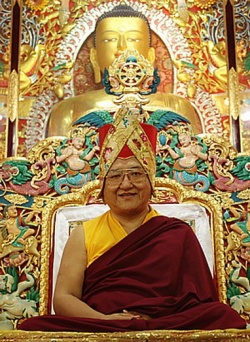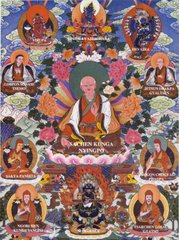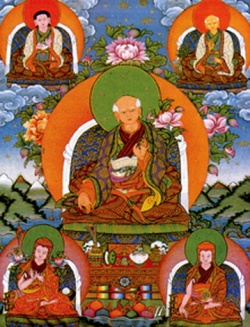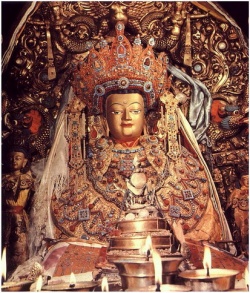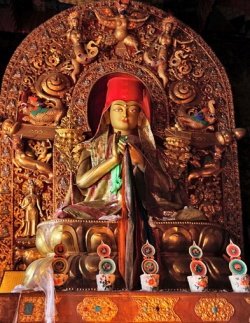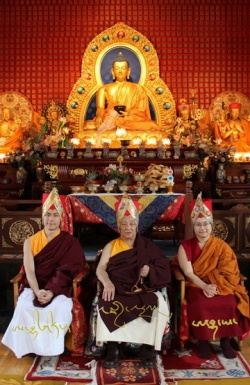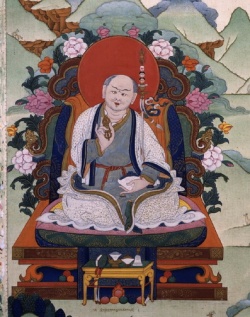Sakya
Sakya (Wyl. sa skya), which is one of the four main traditions of Tibetan Buddhism, takes its name from the Sakya Monastery, founded by Khön Könchok Gyalpo in 1073.
One of the four main schools of Tibetan Buddhism, it was founded in the province of Tsang in 1073 by Khön Könchog Gyälpo (1034–1102), the main disciple of Drogmi Lotsawa (Drogmi Shakya Yeshe, 992–1072). Cf. Nyingma, Kagyü and Gelug.
The name Sakya literally means 'grey earth', and is a reference to the unusually pale colour of the earth at the site. Due to the widespread influence of the monastery's earliest masters, especially the so called 'Five Sakya Patriarchs', it quickly developed into one of the main schools in Tibet, developing a special reputation for scholarship. The most important teaching within the Sakya tradition is the Lamdré, or 'Path with Its Fruit', a series of meditation instructions associated with the Hevajra Tantra.
History
Early History
The Sakya school has its origins in the ancient Khön family of Tibet. Khön Luyi Wangpo was a disciple of Guru Rinpoche and one of the first seven Tibetan monks, the so called 'seven men to be tested'. Several generations later, in 1073, his descendant Khön Könchok Gyalpo founded the monastery of Sakya in Tsang province.
The Sakya tradition was established and spread by five great masters, the 'Sakya Gongma Nam Nga': Sachen Kunga Nyingpo (1092-1158), his two sons Sönam Tsemo (1142-1182) and Drakpa Gyaltsen (1147-1216), his grandson Sakya Pandita (1182-1251) and the latter's nephew Chögyal Pakpa (1235-1280). The Sakya lamas attracted the patronage of the Mongol emperors of China, and in 1253 Kublai Khan conferred the rulership fo the whole of Tibet upon his teacher, Chögyal Pakpa. This political ascendancy of Sakya lasted about a century, but Sakya itself remained an autonomous principality.
During the fourteenth century, Tishri Kunga Lodrö Gyaltsen (1299-1327), eldest grandson of Sakya Pandita’s brother, established four dynastic houses (Tib. labrang): Shyithok, Rinchen Gang, Lhakhang, and Düchö.
Only the Düchö Labrang remains to this day. During the eighteenth century, the Düchö Labrang was split into two ‘cousin’ palaces, by 32nd Sakya Trizin Jamgön Wangdü Nyingpo. These are the Drolma Podrang which was established by his eldest son, Pema Düdul Wangchuk, and the Phuntsok Podrang, established by his youngest son, Kunga Rinchen.
The leadership in the Khön Family and the throneholders of the Sakya school have since then alternated between the Drolma and Phuntsok Podrangs.
The Sakya tradition follows the complete Buddhist teaching of sutras, tantras and the outer sciences, the special teaching of the Sakya school being the Lamdré ('The Path with Its Fruit'), which emphasizes the Hevajra Tantra and derives from the great Indian mahasiddha Virupa. Always stressing study as well as practice, the Sakya school has a reputation for scholarship and has produced a large number of outstanding scholars, such as: Yaktön Sangye Pal, Rongtön Sheja Kunrig, Ngorchen Kunga Zangpo, Gorampa Sönam Senge, Rendawa Shyönnu Lodrö and Shakya Chokden.
During the last century, the Sakya school enjoyed a new wave of creative activity under the inspiration of the great figures of the Rimé movement, such as Jamyang Khyentse Wangpo, Loter Wangpo and Gatön Ngawang Lekpa.
Sakya Today
His Holiness Sakya Trizin, born in 1945, is the present head of the Sakya school, and the 41st in succession. He is renowned as an emanation of both Manjushri and Mahasiddha Virupa, the founder of the Lamdré teachings, and also as an incarnation of Apang Tertön.
Born in Tibet, he escaped with his family to India in 1959 where he continues to live and rebuild both the lay and monastic elements of the Sakya tradition. He has guided the establishment of over thirty monasteries in India and Nepal and has helped found Sakya centres around the world. His elder sister is Jetsün Kushok Chimey Luding. He has two sons, Khonrig Ratna Vajra Sakya and Khondung Gyana Vajra Rinpoche.
In exile in India, H.H. Sakya Trizin has initiated various projects to preserve and promote the great living tradition of the Sakya school. The Sakya Centre in Dehradun, the main seat of the Sakya school and the personal monastery of His Holiness Sakya Trizin, also offers traditional education in Buddhism, rituals, ritual music and dance, art and other related subjects. After completing their studies at the Centre, monks can attend either Sakya College or the Sakya Institute of further education in Higher Buddhist Studies.
The Sakya College is a school of higher philosophical studies where teaching methods are based on those of the Dzongsar shedra in East Tibet established by Jamyang Khyentse Chökyi Lodrö. Dzongsar attracted many of the best scholars throughout Tibet, including Khenpo Appey, the former principal of Sakya College. The main Sakya retreat centre, which was under the direction of the late Chogye Trichen Rinpoche, is located in Nepal.
The Sakya Institute in Puruwala, India, was established in 1980 with the intention of imparting further education in Higher Buddhist Philosophy and Thought with particular emphasis on aspects of the Sakyapa Tradition. The purpose of this Institute is to train young monks to develop into the next generation of teachers.
Among the Sakya centres established in the West is that directed by Sakya Dakchen Rinpoche, the head of the Phuntsok Podrang Palace of the royal Sakya lineage, whose seat is in Seattle.
Subschools
The two main subschools are:
- Ngor, founded by Ngorchen Kunga Zangpo (1382-1456). It is characterized by its rigorous discipline and knowledge of the tantras. Luding Khen Rinpoche, one of the sons of Jetsün Kushok Chimey Luding, is the present head of this school.
- Tsar, founded by Tsarchen Losal Gyatso (1502-1566). The Tsar lineage is renowned for its teachings on the greater and lesser Mahakala, and the transmissions of ‘Thirteen Golden Dharmas’. Its main monastery in Tibet was Dar Drangmoche Monastery in Tsang, and now in exile Tashi Rabten Ling at Lumbini, along with two other monasteries in Kathmandu, Nepal represent the Tsar lineage. His Eminence Chogye Trichen Rinpoche who passed away in 2007 was the head of the Tsar lineage.
Other subschools are:
- The Dzongpa tradition founded by Dzongpa Kunga Namgyal (1432-1496)
Further Reading
- Chogay Trichen, The History of the Sakya Tradition, Ganesha Press, 1983
- Bodhi Magazine, Fall Issue 2009, 'The Glorious Sakya: Lineage of Path and Result'
Internal Links
- Prayer for the Spread of the Sakya Tradition
- Drolma Podrang & Phuntsok Podrang
- Throneholders of the Sakya school
External Links
The Sakya (Tibetan: ས་སྐྱ་, Wylie: sa skya, "pale earth") school is one of four major schools of Tibetan Buddhism, the others being the Nyingma, Kagyu, and Gelug. It is one of the Red Hat sects along with the Nyingma and Kagyu.
History
The Sakya tradition is closely associated with the ancient Tibetan Khon lineage, that according to tradition originated from celestial beings. The lineage has descended until the present day. Khon Konchok Gyelpo (1034-1102) is considered the founder of the Sakya tradition.
In the eleventh century, due to karmic obscurations at that time, dharma practice became very lax and corrupted in Tsang. The head of the family, Sherab Tsultrim, decided that it was time to seek out the new tantra teachings from India. The younger brother, Konchog Gyalpo, studied with Drogmi Lotsawa.
Khon Konchog Gyalpo built the first temple named Gorum Zimchi Karpo in 1073. The temple was built at a location with gray earth (sa skya)at the southern part of the Tsang providence. This place was predicted by both Guru Rinpoche and Lord Atisha to be a place where bodhisattvas and buddhas would appear.
Lord Atisha on his way from India to Tibet in 1040 C.E was said to have made offerings in the location where the monastery would later be built. He also prophesied that this place would witness one bodhisattva Avalokiteshvara incarnation, seven bodhisattva Manjushri incarnations and one bodhisattva Vajrapani incarnation.
This location gave the tradition the name Sakya, even if Khon and lha rig are also equivalent names.
The origins of the specific Sakya doctrines are from the Indian yogi Virupa that transmitted teachings to Gayadhara, that in turn has a Tibetan disciple by the name of Drogmi Shakya Yeshe. Drogmi travelled to India and receive many teachings and empowerments, including the so called Lamdre transmission that originated from Virupa.
Drogmi had a disciple by the name of Khon Konchok Gyelpo that built a monastery in the Tsang providence of central Tibet, and called it Sakya which means 'grey earth' in Tibetan.
The Sakya tradition was established by the Five Superiors of the Sakya Tradition: Sachen Kunga Nyingpo, Sonam Tsemo , Jetsun Drakpa Gyeltsen, Sakya Pandita Kunga Gyeltsen and Drogon Chogyal Phagpa.
The current head of the Sakya tradition is His Holiness Sakya Trizin.
For more information, see Sakya Masters for information about many Sakya lamas.
See the Sakya Literature index for references to Sakya material.
Lineages
Teachings
Alternate Names & Spellings
Reference
- The History of the Sakya Tradition by Chogay Trichen, ISBN 0-9509-1190-9
Origins
The name Sakya ("pale earth") derives from the unique grey landscape of Ponpori Hills in southern Tibet near Shigatse, where Sakya Monastery, the first monastery of this tradition, and the seat of the Sakya School was built by Khon Konchog Gyalpo (1034–1102) in 1073.
The Sakya tradition developed during the second period of translation of Buddhist scripture from Sanskrit into Tibetan in the late 11th century. It was founded by Drogmi, a famous scholar and translator who had studied at the Vikramashila University directly under Naropa, Ratnākaraśānti, Vagishvakirti and other great panditas from India for twelve years.
Konchog Gyalpo became Drogmi's disciple on the advice of his elder brother.
The tradition was established by the "Five Venerable Supreme Masters" starting with the grandson of Khonchog Gyalpo, Kunga Nyingpo, who became known as Sachen, or "Great Sakyapa":
Sachen Kunga Nyingpo (1092–1158) Sonam Tsemo (1142–1182) Drakpa Gyaltsen (1147–1216) Sakya Pandita (1182–1251) Chogyal Pakpa (1235–1280)
Buton Rinchen Drub (1290–1364) was an important scholar and writer and one of Tibet's most celebrated historians. Other notable scholars of the Sakya tradition are the so called "Six Ornaments of Tibet:"
Yaktuk Sangyey Pal Rongton Sheja Kunrig (1367–1449) Ngorchen Kunga Zangpo Zongpa Kunga Namgyel Gorampa Sonam Senge (1429–1489) Shakya Chogden (1428–1507)
The leadership of the Sakya School is passed down through a hereditary system between the male members of the Sakya branch of the Khon family.
Teachings
Sachen, the first of the five supreme masters, inherited a wealth of tantric doctrines from numerous Tibetan translators or "lotsawas" who had visited India: most importantly Drokmi Lotsawa, Bari Lotsawa and Mal Lotsawa. From Drokmi comes the supreme teaching of Sakya, the system of Lamdré (lam 'bras) or "Path and its Fruit", deriving from the mahasiddha Virupa, based upon the Hevajra Tantra.
Mal Lotsawa introduced to Sakya the esoteric Vajrayogini lineage known as "Naro Khachoma." From Bari Lotsawa came innumerable tantric practices, foremost of which was the cycle of practices known as the One Hundred Sadhanas. Other key transmissions that form part of the Sakya spiritual curriculum include the cycles of Vajrakilaya, Mahakala and Guhyasamaja.
The fourth Sakya patriarch, Sakya Pandita, was notable for his exceptional scholarship and composed many important and influential texts on sutra and tantra, including, Means of Valid Cognition: A Treasury of Reasoning (tshad ma rigs gter), Clarifying the Sage's Intent (thub pa dgongs gsal) and Discriminating the Three Vows (sdom gsum rab dbye).
The main Dharma system of the Sakya school is the Path with Its Result (lam dang 'bras bu bcas), which is split into two main lineages, Explanation for the Assembly (tshogs bshad) and the Explanation for Close Disciples (slobs bshad).
The other major Dharma system of the Sakya school is the Naropa Khechari Explanation For Disciples (Naro mkha spyod slob bshad).
Subschools
In due course, two subsects emerged from the main Sakya lineage,
Ngor, founded in Tsang by Ngorchen Kunga Zangpo (1382–1457). The Ngor school is centered around Ngor Evam Choden monastery. It represents 85% of the Sakyapa school and most if not all the monasteries in India are Ngorpa, apart from Sakya Trizin's monastery. Tshar, founded by Tsarchen Losal Gyamtso (1496 - 1560 or 1502–1556).
There were three "mother monasteries of the Sakya school: Sakya Monastery, founded in 1073, Ngor Evam Choden, founded in 1429, and Phanyul Nalendra in Phanyul, north of Lhasa, founded in 1435 by Kuntchen Rongten. Nalendra became the home of the 'whispered-lineage' of the Tsar school. Feudal lordship over Tibet Further information: Tibet under Yuan administrative rule and Tibet during the Ming Dynasty
The Mongols invaded Tibet after the foundation of their empire in the early 13th century. In 1264 the feudal reign over Tibet was given to Phagpa by the Mongolian emperor Kublai Khan. Sakya lamas continued to serve as viceroys of Tibet on behalf of Yuan emperors for nearly 75 years after Phagpa’s death (1280), until the Yuan Dynasty was greatly weakened by the Red Turban Rebellion in the 1350s, a decade before the Ming Dynasty founded by native Chinese overthrew Mongol rule in China. The leaders of the Sakya regime were as follows.
Phagpa 1253-1280 Dharmapala Raksita 1280-1282, d. 1287 Jamyang Rinchen Gyaltsen 1286-1303 Zangpo Pal 1306-1323 Khatsun Namka Lekpa Gyaltsen 1325-1341 Jamyang Donyo Gyaltsen 1341-1344 Lama Dampa Sonam Lotro Gyaltsen 1344-1347 Lotro Gyaltsen 1347-1365
Sakya today
The head of the Sakya school, known as Sakya Trizin ("holder of the Sakya throne"), is always drawn from the male line of the Khön family. The present Sakya Trizin, Ngawang Kunga Tegchen Palbar Trinley Samphel Wanggi Gyalpo, born in Tsedong in 1945, is the forty-first to hold that office.
41st Sakya Trizin is the reincarnation of two great Tibetan masters: a Nyingmapa lama known as Apong Terton (Orgyen Thrinley Lingpa), who is famous for his Red Tara cycle, and his grandfather, the 39th Kyabgon Sakya Trizin Dhagtshul Thrinley Rinchen (1871–1936).
Today, he resides in Rajpur, India along with his wife, Gyalyum Kushok Tashi Lhakyi, and two sons Ratna Vajra Rinpoche and Gyana Vajra Rinpoche. Ratna Vajra Rinpoche being the older son, is the lineage holder and is married to Dagmo Kalden Dunkyi Sakya and Gyana Vajra Rinpoche is married to Dagmo Sonam Palkyi Sakya.
Traditionally hereditary succession alternates between the two Sakya palaces since Khon Könchok Gyelpo's (1034–1102) reign. The Ducho sub-dynasty of Sakya survives split into two palaces, the Dolma Phodrang and Phuntsok Phodrang. Sakya Trizin is head of the Dolma Phodrang. H.H. Jigdal Dagchen Sakya (b. 1929) is the head of the Phuntsok Phodrang, and lives in Seattle, Washington, where he co-founded Sakya Monastery of Tibetan Buddhism with Dezhung Rinpoche III, and constructed the first Tibetan Buddhist Monastery in the United States.
Dagchen Sakya's father was the previous Sakya Trizin, Trichen Ngawang Thutop Wangchuk, throne holder of Sakya, and his mother Dechen Drolma. Dagchen Sakya is married to Her Eminence Dagmo Jamyang Kusho Sakya; they have five sons, and several grandchildren.
Members of Sakya Colleges are called Zhoima Pochang (Tibetan: ལ་མ་་ང༌།, ZYPY: Zhöma Pochang).
During the 19th century the great Sakya master and terton Jamyang Khyentse Wangpo, the famous Kagyu master Jamgon Kongtrul Lodro Thaye and the important Nyingma terton Orgyen Chokgyur Lingpa founded the Rime movement, an alleged ecumenical attempt to incorporate all teachings of all schools, to overcome the separation of Buddhist transmission in different traditions.
This movement still influences modern Tibetan Buddhist practice through the "five great treasures" of Jamgon Kongtrul and the treasure of rediscovered teachings (Rinchen Terdzöd).
The history of Sakya, one of the four major schools of Tibetan Buddhism, is firmly rooted in Tibet's rich mythology. The leaders of Sakya are and have always been from a single aristocratic clan, the Khon. It's said that the first Khon was born after his father defeated a vampire and married the vampire's wife.
Vampires or not, the Khon married into Tibet's imperial family during the time of the Tibetan Empire -- roughly the 7th to 11th centuries. The prominent clan maintained tantric practices from the imperial period and passed them from father to son.
The Sakya school began with Khon Konchok Gyalpo (1034-1102). Konchok Gyalpo was riding through a marketplace one day and saw tantric songs beings performed in the open, as street theater. Konchok Gyalpo was dismayed; he believed tantra should remain esoteric and uncorrupted by public display.
Konchok Gyalpo went on to study Indian tantra and combined what he learned with his family's tantra practices. Then in 1073 Konchok Gyalpo built a retreat center at Sakya, in the Tsang region of central Tibet. This would be the seat of the Sakya school until its residents fled the Chinese in the 1950s.
Konchok Gyalpo's son Sachen Kunga Nyingpo (1092-1158) further developed the teachings of the Sakya school. One of his teachings -- said to have come from the Bodhisattva Manjusri in a vision -- is "letting go of the four attachments." The four attachments are this life, future lives, personal welfare, and any fixed concept of reality.
Sachen had a translation of a tantric text called Lamdre, "the path and its result." Lamdre is a systematically structured meditation path of high tantra Vajrayana.
Sachen wished to receive empowerments and teachings in Lamdre from a living master. Although he had the texts, the texts unconnected to one who had realized the teachings were a mere book. Sanchen eventually found such a teacher, and received the teachings. Lamdre became a foundational practice of Sakya.
Sachen and the next four Sakya patriarchs came to be called the Five Venerable Supreme Masters. The remaining four are Sachen Kunga Nyingpo (1092-1158); Sonam Tsemo (1142-1182); Drakpa Gyaltsen (1147-1216); Sakya Pandita (1182-1251); and Chogyal Papga (1235-1280).
In addition to texts common to other schools of Tibetan Buddhism, the writing of the Five Venerable Supreme Masters serve as a canon of scripture important to Sakyapa. Two other scholars are worthy of mention -- Gorampa Sonam Senge (1429-1489) and Panchen Shakya Chokden (1428-1507). Their commentaries on the sutras and tantras are studied by scholars of all Tibetan schools. Sakya in Tibetan Politics
At the time Sakya was founded, the Tibetan Empire was fragmented. Then came a period of Mongol conquest. Under Genghis Khan (1162? - 1227) the Monglians became a formidable military power. In 1240 Genghis Khan's grandson Godan Khan ordered a new invasion, sending a Mongolian general and 30,000 troops into Tibet.
In time, Tibet was absorbed into the Mongolian Empire, and the abbot of Sakya was summoned to the court of Godan Khan to be his spiritual adviser and representative of central Tibet. This abbot was Pandita Kunga Gyeltsen one of the Five Venerable Supreme Masters listed above. Pandita spent the rest of his life among the Mongolians, never returning to Sakya. In 1252 the last of the Venerable Supreme Masters, Drogon Chogyal Pagpa)], took over Sakya Pandita position at the Mongol court.
By now another grandson of Genghis Khan was gaining prominence among the Mongolians -- Kublai Khan (1215-1294). Kublai became interested in Buddhism and received empowerments and teachings from Pagpa. This linked the two men as disciple and guru, an unbreakable relationship.
In time, Kublai Khan would rule much of Asia, including China. Through his influence Pagpa, with a small army, returned to Tibet as "state preceptor." Pagpa and the Sakyas became the highest political and spiritual authority in much of Tibet, and the Sakya school ruled Tibet on behalf of the Mongols for about a century. Then Jangchub Gyaltsen of the Pagmodru clan overthrew the Sakyas in 1353, and Mongolian influence diminished. The Three Sakya Schools
The main Sakya school to this day is under the leadership of the Khon clan. The head of Sakyapa is the "Sakya Trizin" ("the holder of the Sakya throne").
From the main Sakya school, two distinctive sub-schools emerged.
Ngorpa. Founded by Ngorchen Kunga Zangpo (1382-1457), Ngorpa emphasizes monastic discipline.
Tsarpa, Founded by Tsarchen Losal Gyatso (1502-56), known for teachings preserved in the Thirteen Golden Texts of Tsar. Sakya Today
The present head of Sakyapa is His Holiness the Sakya Trizin, Ngakwang Kunga Thekchen Palbar Samphel Ganggi Gyalpo. His Holiness was born in 1945 in Tsedong, Tibet, and is the 41st throne holder. He lives in Raipur, India, with his wife Dakmo Tashi Lhakyi. They have two sons.
